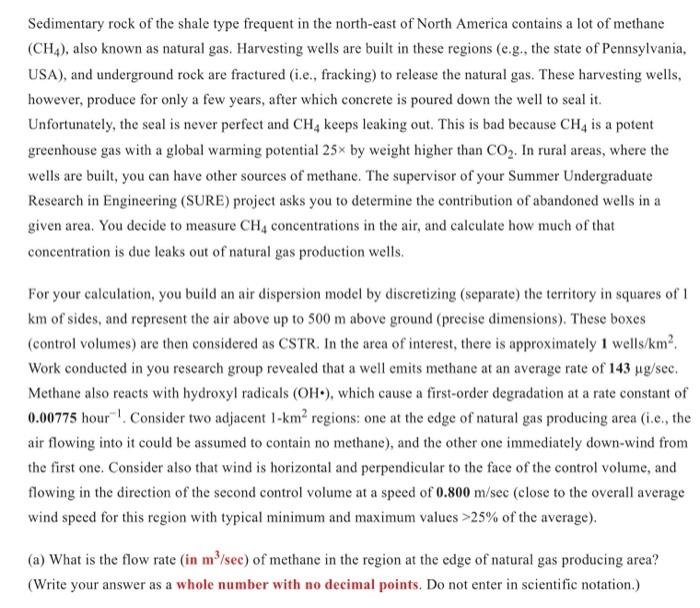Sedimentary rock of the shale type frequent in the north-east of North America contains a lot of methane (CH4), also known as natural gas. Harvesting wells are built in these regions (e.g., the state of Pennsylvania, USA), and underground rock are fractured (i.e., fracking) to release the natural gas. These harvesting wells, however, produce for only a few years, after which concrete is poured down the well to seal it. Unfortunately, the seal is never perfect and CH4 keeps leaking out. This is bad because CH4 is a potent greenhouse gas with a global warming potential 25 by weight higher than CO2. In rural areas, where the wells are built, you can have other sources of methane. The supervisor of your Summer Undergraduate Research in Engineering (SURE) project asks you to determine the contribution of abandoned wells in a given area. You decide to measure CH4 concentrations in the air, and calculate how much of that concentration is due leaks out of natural gas production wells. For your calculation, you build an air dispersion model by discretizing (separate) the territory in squares of 1 km of sides, and represent the air above up to 500m above ground (precise dimensions). These boxes (control volumes) are then considered as CSTR. In the area of interest, there is approximately 1 wells /km2. Work conducted in you research group revealed that a well emits methane at an average rate of 143g/sec. Methane also reacts with hydroxyl radicals (OH), which cause a first-order degradation at a rate constant of air flowing into it could be assumed to contain no methane), and the other one immediately down-wind from the first one. Consider also that wind is horizontal and perpendicular to the face of the control volume, and flowing in the direction of the second control volume at a speed of 0.800m/sec (close to the overall average wind speed for this region with typical minimum and maximum values >25% of the average). (a) What is the flow rate (in m3/sec ) of methane in the region at the edge of natural gas producing area? (Write your answer as a whole number with no decimal points. Do not enter in scientific notation.) (b) What do you expect to be the steady-state concentration of methane (g/m3) in the region down-wind from the first region? (Write your answer up to 5 decimal points. Do not enter in scientific notation.) Note the new values for the site: Wells/ km2:6 Methane emission rate: 148g/sec First-order degradation rate constant of methane with hydroxyl radical: 0.00880 hour 1 Horizontal wind speed through control volume: 0.714m/sec (c) Calculate the time it takes to reach precisely 95% of the steady-state in the first region if you start with the atmospheric concentration as C0=50% of C (give the time in hours)? Since steady-state is only reached at an infinite time, this time is when the system is considered to have reached steady-state. (Write your answer up to 3 significant digits or 3 decimal points.) degradation rate constant of methane with hydroxyl radical: 0.00824 hour 1 Horizontal wind speed through control volume: 0.775m/sec









